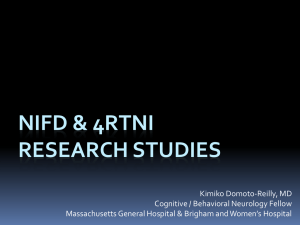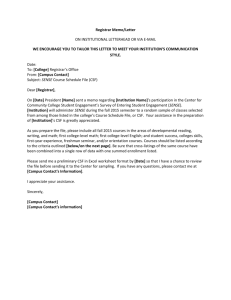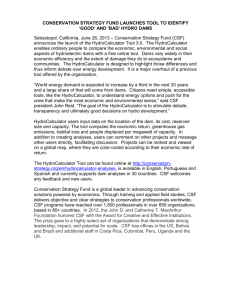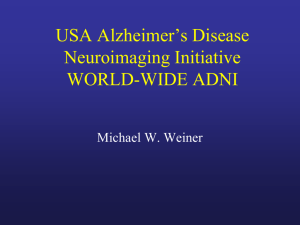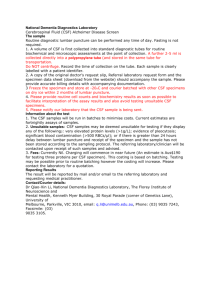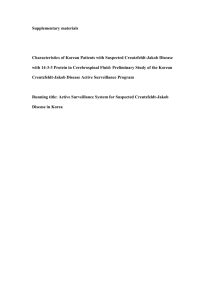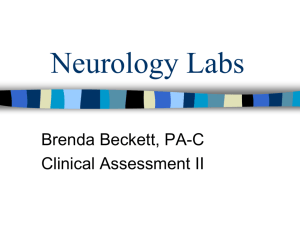ADNI-3 Biomarker Core - Alzheimer's Association
advertisement
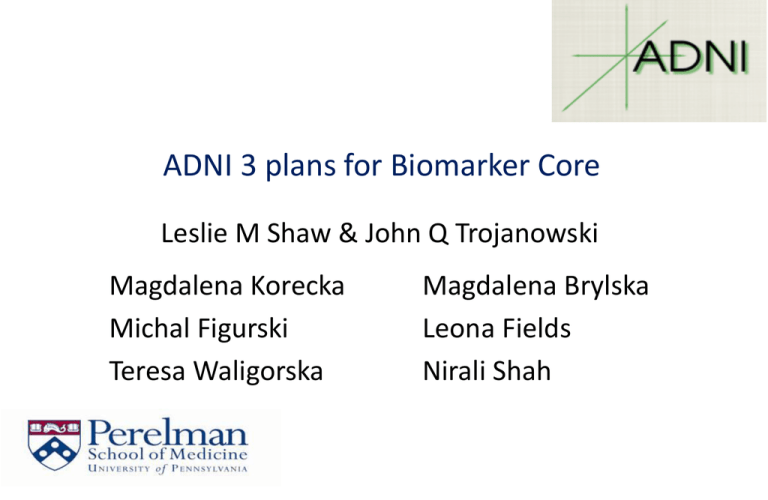
ADNI 3 plans for Biomarker Core Leslie M Shaw & John Q Trojanowski Magdalena Korecka Michal Figurski Teresa Waligorska Magdalena Brylska Leona Fields Nirali Shah Biomarker Core Aims for ADNI 3 1. Continue to collect, store, curate and track all biofluid samples collected from subjects in ADNI-1, ADNI-GO, ADNI-2 and ADNI-3 and continue regular reconciliation and reviews with the clinical core at UCSD. Provide blinded sample aliquots for studies approved by the NIA/ADNI/RARC. 2. Implement new test methods for CSF biomarkers: a. Implement new automated immunoassay platform for CSF Ab1-42, t-tau and p-tau181, following validation study and review of all possible systems in consultation with PPSB BBWG. b. Implement our newly validated mrmMass Spec assay to measure Ab1-42, Ab1-40 and Ab1-38 in all ADNI CSFs. c. Establish validated Mass Spectrometry-based assay to identify and measure t-tau and, possibly, tau isoforms in CSF d. Implement other validated and promising new biomarker immunoassays such as those that measure other species of tau in CSF, including fragments of tau. We are following closely any promising lead for plasma biomarkers with predictive value and exosomes as a potentially valuable carrier of CNS biomarkers in the circulation. The results from these ongoing studies will determine the likelihood of incorporating these new analytes into ADNI-3. e. Partner with the PPSB and other investigators who pursue additional approved Add-On studies of AD biomarkers in plasma and/or CSF in order to bring these assays on-line for use in ADNI 3. Continue longitudinal studies of ADNI biomarkers that are most informative including CSF t-tau, p-tau181 and Aβ1-42. Neurogranin and Vilip 1 data recently uploaded and total a-syn and PS129-a-syn, YKL40 data will be available later this year. We propose to add the most promising of these as opportunities to improve on our CSF AD panel in order to chart the onset and progression of AD and determine earliest predictors of cognitive decline. 3. 4. Collaborate in studies of best combinations of biomarkers for prediction of cognitive and functional decline, both withinbiomarker core as well as with other cores and investigators such as the FNIH biomarker consortium. 5. Continue international collaboration (AA GBSC & IFCC CSF WG) to establish a certified reference material for Ab1-42 that supports improved analytical platform to platform, lot-to-lot performance, and to promote harmonization across analytical methods for these widely used CSF biomarkers. Selection of a new automated immunoassay platform for ADNI 3 • Move from a manual RUO immunoassay to a fully automated immunoassay platform for ADNI 3: due diligence started Q4, 2014. • This follows extensive discussions over past few years with stakeholders • Need for preliminary validation data for ADNI 3 grant submission • Sought after features: – precision & accuracy based; dilutional linearity, parallelism – Excellent level of intra- and inter-lab performance – full automation; – commitment to the ADNI study; – on an IVD trajectory; – commitment to pre-competitive activities, to contribute to CSF biomarker QC/standardization – Commitment to data sharing consistent with the ADNI study • Selection will be done in consultation with the ADNI PPSB/BBWG/DDWG, chaired by Johan Luthman. ADNI subjects with BASELINE normal CSF Ab1-42: In some CSF Ab1-42 remains stable/normal & in some declines to abnormal “stable”, non-decliners B “decliners” Toledo, et al, 2013 20 stable, -0.5pg/mL/yr 14 decliners, -9.2 pg/mL/yr C Landau et al, 2013 * Subjects in the ADNI 1 add-on study, sponsored by an anonymous donor, included a total of 141 subjects with 3 or more CSFs collected longitudinally between 2005 - 2014 Mattsson, et al, 2015 Support of standardization efforts • ADNI-longterm commitment to standardization of all methods — Open access to data generated following quality control — Has been in operation for 10 years — Benefits from lots of interaction, peer review, with the scientific community in academia, industry, governmental sectors • Alz Assn Global Biomarker Standardization Consortium — Analytical methods standardization--strong support for improved performance of existing and new immunoassays for CSF biomarkers, and automation — The Alz Assn-supported international CSF QC program provides continuing feedback on quality both short and long term — Support for mrm/tandem mass spectrometry for direct measurement of absolute Ab1-42 concentration — IFCC/IRMM project to develop reference Ab1-42 peptide material and using mrm/msms and large pools of CSF with accurately measured Ab1-42 — Need same for t-tau • CAMD(Coalition Against Major Diseases) has made a substantial commitment to support FDA approval for the use of HV and CSF AD biomarkers in treatment trials — Hippocampal volume — CSF AD biomarkers • • • BIOMARKER CORE AIMS FOR THE ADNI-3 RENEWAL Leslie M. Shaw and John Q. Trojanowski It is important to take into account the heterogeneity of AD in the ADNI-3 Biomarker Core in ADNI3. Many studies emphasize this including ADNI data showing that that a very small minority (4/22) of ADNI subjects with clinical AD/MCI only had AD plaque and tangle pathology at autopsy, while 82% had plaques and tangles in addition to TDP-43 and/or alpha-synuclein (a-syn) inclusions as well as hippocampal sclerosis in some cases (Toledo et al, ANP Commun, 1:65, 2013). These findings are echoed in a larger study of non-ADNI Penn subjects (Toledo et al, ANP, 124:23-35, 2012). Further, we have used a CSF total a-syn assay in ADNI CSF samples that may enable detection of co-morbid LBs in MCI/AD subjects in ADNI 3 (Toledo et al, ANP, 126:683-697, 2013) and we also have access to a phospho-a-syn immunoassay that could be incorporated into ADNI-3 (Wang et al, Sci Trans Med, 4:121-20, 2/15/2012). TDP-43 biomarkers are not yet available so we work with Hugo Vanderstichele at ADx and Andreas Jeromin at Quanterex on TDP-43 ELISA based assays, but it is not yet certain if a TDP-43 immunoassay will be ready for use in ADNI-3. We also need to address the issue of co-morbid cerebro-vascular disease (CVD), but information on CVD may come from imaging rather than chemical biomarker studies. Alzheimer’s Disease: heterogeneity and biomarker timeline dynamics Kang JH, et al, AlzDement, 2015 Biomarker Core Aims for ADNI 3 1. Continue to collect, store, curate and track all biofluid samples collected from subjects in ADNI-1, ADNI-GO, ADNI-2 and ADNI-3 and continue regular reconciliation and reviews with the clinical core at UCSD. Provide blinded sample aliquots for studies approved by the NIA/ADNI/RARC. 2. Implement new test methods for CSF biomarkers: a. Implement new automated immunoassay platform for CSF Ab1-42, t-tau and p-tau181, following validation study and review of all possible systems in consultation with PPSB BBWG. b. Implement our newly validated mrmMass Spec assay to measure Ab1-42, Ab1-40 and Ab1-38 in all ADNI CSFs. c. Establish validated Mass Spectrometry-based assay to identify and measure t-tau nd, possibly, tau isoforms in CSF d. Implement other validated and promising new biomarker immunoassays such as those that measure other species of tau in CSF, including fragments of tau. We are following closely any promising lead for plasma biomarkers with predictive value and exosomes as a potentially valuable carrier of CNS biomarkers in the circulation. The results from these ongoing studies will determine the likelihood of incorporating these new analytes into ADNI-3. e. Partner with the PPSB and other investigators who pursue additional approved Add-On studies of AD biomarkers in plasma and/or CSF in order to bring these assays on-line for use in ADNI 3. Continue longitudinal studies of ADNI biomarkers that are most informative including CSF t-tau, p-tau181 and Aβ1-42. Neurogranin and Vilip 1 data recently uploaded and total a-syn and PS129-a-syn, YKL40 data will be available later this year. We propose to add the most promising of these as opportunities to improve on our CSF AD panel in order to chart the onset and progression of AD and determine earliest predictors of cognitive decline. 3. 4. Collaborate in studies of best combinations of biomarkers for prediction of cognitive and functional decline, both within-biomarker core as well as with other cores and investigators such as the FNIH biomarker consortium. 5. Continue international collaboration (AA GBSC & IFCC CSF WG) to establish a certified reference material for Ab1-42 that supports improved analytical platform to platform, lot-to-lot performance, and to promote harmonization across analytical methods for these widely used CSF biomarkers. New biomarkers in NIA/ADNI/RARC-approved studies Biomarker Fluid # ADNI study Investigator Proteome/RBM plasma 1,065 BL & yr1; multiple publications HSoares;Pfizer/PPSB/FNIH Proteome/RBM CSF 317 BL ADNI 1; multiple publications WPotter,etal/PPSB/FNIH BACE & sAPP CSF 402 BL ADNI 1; recent publication MSavage;merck/PPSB/FNIH a-Synuclein;xMAP CSF 390 BL ADNI 1; several publications JZhang; University of Wash Proteome/ MRM/tandem MSMS CSF 331 BL ADNI 1; 567 tryptic peptides associated with 221 proteins; recent publication, another planned ADNI PPSB/FNIH; LHonigsberg Neurogranin; IA NFIL; IA CSF 416 BL ADNI 1; manuscript accepted; manuscript submitted KBlennow; Sahlgrenska UHosp DDE; LC/msms plasma 211 AD vs controls, ADNI 1 ALevey; Emory University Vilip 1; HS IA CSF 612 ADNI 1, GO, 2 in longitudinal samples 2015 AAIC abstract, pub. planned AFagan; Wash University Phos-a-SYN;xMAP CSF 567 Study in BL & longitudinal samples JZhang; University of Wash YKL40, SNAP25 & neurogranin CSF 612 Studies in longitudinal samples data just uploaded AFagan; Wash University Metabolic networks serum 833 Studies in BL samples RKaddoura-Daouk; Duke Univ, Phenomenone Ab1-42/1-40;ELISA plasma 764 ADNI 1, GO, 2 in BL & longitudinal ISherriff; Araclon Biotech
